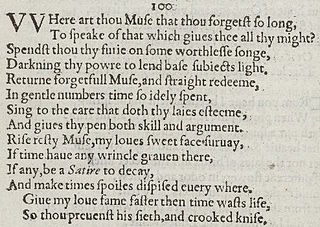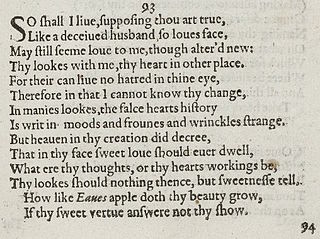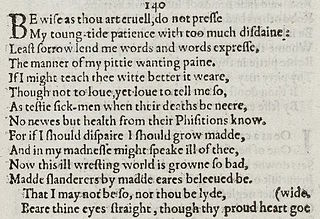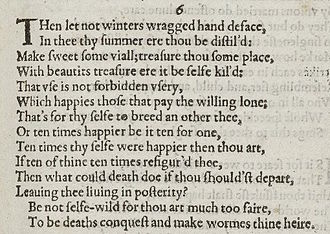
Sonnet 8 is one of 154 sonnets written by the English playwright and poet William Shakespeare. It is a procreation sonnet within the Fair Youth sequence. As with the other procreation sonnets, it urges a young man to settle down with a wife and to have children. It insists a family is the key to living a harmonious, peaceful life.

Sonnet 22 is one of 154 sonnets written by the English playwright and poet William Shakespeare, and is a part of the Fair Youth sequence.
Sonnet 24 is one of 154 sonnets written by the English playwright and poet William Shakespeare, and is a part of the Fair Youth sequence.

Sonnet 38 is one of 154 sonnets written by the English playwright and poet William Shakespeare. It is a member of the Fair Youth sequence, in which the lyric subject expresses its love towards a young man.

Sonnet 48 is one of 154 sonnets written by the English playwright and poet William Shakespeare. It is a member of the Fair Youth sequence, in which the poet expresses his love towards a young man.

Sonnet 49 is one of 154 sonnets written by the English playwright and poet William Shakespeare. It is a member of the Fair Youth sequence, in which the poet expresses his love towards a young man.

Sonnet 51 is one of 154 sonnets written by the English playwright and poet William Shakespeare. It is part of the Fair Youth sequence, in which the poet expresses his love towards a young man. It is a continuation of the argument from Sonnet 50.

Sonnet 100 is one of 154 sonnets written by the English playwright and poet William Shakespeare. It is a member of the Fair Youth sequence, in which the poet expresses his love towards a young man.

Sonnet 93 is one of 154 sonnets written by the English playwright and poet William Shakespeare. It is a member of the Fair Youth sequence, in which the poet expresses his love towards a young man.

Sonnet 134 is one of 154 sonnets written by the English poet and playwright William Shakespeare. In it, the speaker confronts the Dark Lady after learning that she has seduced the Fair Youth.
Sonnet 149 is one of 154 sonnets written by the English playwright and poet William Shakespeare.

Sonnet 148 is one of 154 sonnets written by the English playwright and poet William Shakespeare.

Sonnet 140 is one of 154 sonnets written by the English playwright and poet William Shakespeare. Sonnet 140 is one of the Dark Lady sonnets, in which the poet writes to a mysterious woman who rivals the Fair Youth for the poet's affection.

Sonnet 139 is one of 154 sonnets written by the English playwright and poet William Shakespeare.

Sonnet 90 is one of 154 sonnets written by the English playwright and poet William Shakespeare. It is a member of the Fair Youth sequence, in which the poet expresses his love towards a young man.

Sonnet 95 is one of 154 sonnets written by the English playwright and poet William Shakespeare. It is a member of the Fair Youth sequence, in which the poet expresses his love towards a young man.

Sonnet 96 is one of 154 sonnets written by the English playwright and poet William Shakespeare. It is a member of the Fair Youth sequence.

Sonnet 103 is one of 154 sonnets written by the English playwright and poet William Shakespeare. It is a member of the Fair Youth sequence, in which the poet expresses his love towards a young man.
Sonnet 120 is one of 154 sonnets written by the English playwright and poet William Shakespeare. It's a member of the Fair Youth sequence, in which the poet expresses his love towards a young man.

Shakespeare's sonnet 117 was first published in 1609. It uses similar imagery to Sonnet 116 and expands on the challenge in the closing couplet. Using legally resonant metaphors, the poet defends himself against accusations of ingratitude and infidelity by saying that he was merely testing the constancy of those same things in his friend.



















